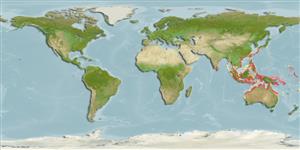>
Gobiiformes (Gobies) >
Oxudercidae (Mudskippers) > Periophthalminae
Etymology: Boleophthalmus: Name from Greek, ßoƛɛ for ejected and 'ophthalmos' for eye; refers to species capability to rapidly raise their eyes above the level of their orbital cavities, as if the eyes were being ejected..
Environment: milieu / climate zone / depth range / distribution range
Ökologie
seewasser; süßwasser; brackwasser demersal. Tropical
Indo-West Pacific: endemic to Australia.
Size / Gewicht / Alter
Maturity: Lm ? range ? - ? cm
Max length : 11.1 cm SL Männchen/unbestimmt; (Ref. 93058)
Rückenflossenweichstrahlen (insgesamt): 23-25; Afterflossenweichstrahlen: 22 - 24. Distinguished by the following characteristics: total elements in D2 23-25; caudal fin length 17.9-24.6% SL; head length 26.6-31.1 % SL; length of D2 base 38.2-43.5%; first D2 element usually segmented and unbranched; longitudinal scale count 89-111; predorsal scales 38-60;
lower jaw teeth atypical for Boleophthalmus, notch lacking, teeth more rounded than congeners (Ref. 5218).
Facultative air-breathing (Ref. 126274); Amphibious air-breather (Ref. 31184). Max. length (Edward O. Murdy, pers. comm., 2000).
Life cycle and mating behavior
Geschlechtsreife | Fortpflanzung | Ablaichen | Eier | Fecundity | Larven
Kailola, P.J., 1991. The fishes of Papua New Guinea: a revised and annotated checklist. Vol. III. Gobiidae to Molidae. Research Bulletin No. 41, Research Section, Dept. of Fisheries and Marine Resources, Papua New Guinea. 153 p. (Ref. 6771)
IUCN Rote Liste Status (Ref. 130435)
Bedrohung für Menschen
Harmless
Nutzung durch Menschen
Mehr Information
NamenSynonymeMetabolismusRäuberÖkotoxikologieFortpflanzungGeschlechtsreifeAblaichenSpawning aggregationFecundityEierEientwicklung
ReferenzenAquakulturAquakultur ProfilZuchtlinienGenetikElectrophoresesVererbbarkeitKrankheitenVerarbeitungNutrientsMass conversion
PartnerBilderStamps, Coins Misc.LauteCiguateraGeschwindigkeitSchwimmstilKiemenoberflächeOtolithsGehirngrößeSehfähigkeit
Tools
Zusatzinformationen
Download XML
Internet Quellen
Estimates based on models
Preferred temperature (Ref.
123201): 25.4 - 29.2, mean 28.4 °C (based on 1050 cells).
Phylogenetic diversity index (Ref.
82804): PD
50 = 0.5156 [Uniqueness, from 0.5 = low to 2.0 = high].
Bayesian length-weight: a=0.00724 (0.00336 - 0.01560), b=2.95 (2.76 - 3.14), in cm total length, based on LWR estimates for this (Sub)family-body shape (Ref.
93245).
Widerstandsfähigkeit (Ref.
120179): hoch, Verdopplung der Population dauert weniger als 15 Monate. (Preliminary K or Fecundity.).
Fishing Vulnerability (Ref.
59153): Low vulnerability (10 of 100).
